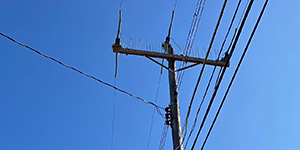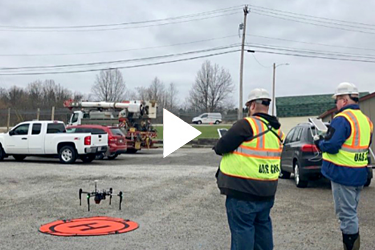BIODIVERSITY COMMITMENT AND CONSERVATION PRACTICES
FirstEnergy’s electric transmission system spans approximately 24,000 miles of lines connecting the Midwest and Mid-Atlantic regions and includes more than 13,000 miles of rights-of-way (ROW) transmission corridors. As we build and maintain our infrastructure to help ensure reliable electric service for our customers, we continue to focus on preserving and protecting the environment. Beyond improvements to our own work practices, we collaborate with and support a range of organizations dedicated to habitat conservation across approximately 128,000 manageable acres.
Our corporate Biodiversity Commitment guides our actions to protect wildlife and support habitat conservation. Our commitment includes using integrated vegetation management (IVM) best practices to establish and maintain a mixture of grasses, shrubs and other vegetation that yields thriving, biodiverse habitats in our transmission corridors. Through continued collaboration with industry groups and research institutes, we continuously work to improve utility and vegetation management best practices.
INTEGRATED VEGETATION MANAGEMENT
IVM is the process by which our Vegetation Management team evaluates our transmission corridors to assess tall-growing woody vegetation that can interfere with transmission lines and equipment. The team develops and implements corresponding controls such as herbicide application, manual pruning and mowing, along with tree and brush removal as necessary.
Our IVM process aligns with our Biodiversity Commitment and includes the use of ecologically focused management practices that foster compatible, low-growing and biodiverse plant communities that require less maintenance in the long run. This helps us reduce costs and provide more reliable service to our customers.
The tracking and reporting of herbicides through our Closed Chain of Custody (CCC) process sets high standards for our IVM program. Using this standardization process across the entire system enhances safety and productivity, improves compliance priorities and public education, and decreases liability.
The CCC process requires the use of a closed loop container system, container recycling, and scannable tracking number; this provides key metrics that help us improve our processes and aligns with industry best management practices.
CREATING POLLINATOR-FRIENDLY HABITATS
IVM also enables FirstEnergy to use our extensive transmission corridors to create pollinator-friendly habitats that sustain healthy populations of bees, butterflies and other pollinating insects, which play a critical role in sustaining a healthy environment. Not only do they pollinate plants that produce one-third of the food we eat, they also help maintain vegetation that cleans the air, prevents soil erosion and supports other wildlife. We believe well-managed rights-of-way that exceed minimum standards of care can provide the food and cover that wildlife needs to survive.
As part of the Vegetation Management program, the New Construction team has worked to support diverse pollinator habitats by starting a pollinator seed mix initiative. Following construction projects within the FirstEnergy footprint, we use a region-specific pollinator seed mix in place of traditional grass mixes in an effort to promote diverse, early successional habitats of native species.
Since the Pollinator Seed Mix program began in 2020, we’ve planted more than 214 acres of newly created pollinator habitat, making significant progress toward our goal to create 225 acres of biodiverse habitats on utility rights‐of-way and company properties across our service area by 2025. The program aims to replace traditional grass seed with native pollinator seed mixes after initial clearing activities on the rights-of-way.
In addition to cultivating plant life that supports pollinators in our transmission corridors, FirstEnergy also partners with organizations on various pollinator initiatives and participates in collaborative research studies that help us develop increasingly sustainable vegetation management practices.
We are a founding cooperator on the Pennsylvania State Game Lands 33 (SGL33) research project, which began in 1952 in response to public concern about the impact of vegetation management practices on wildlife habitat along a transmission corridor. Today, we work with researchers from Penn State who continue to study the effects of vegetation management practices on the wildlife habitats at SGL33 sites. These continuous studies have demonstrated that our IVM work under transmission lines is key to the creation of diverse, early successional plant communities, which provide the healthy, sustainable habitats that pollinators and other animal species rely on. Additionally, we participate in the EPRI Power-in-Pollinator initiative and Monarch Butterfly Candidate Conservation Agreement with Assurances (CCAA).
PROMOTING CONSERVATION AND POLLINATION
As part of our commitment to be good stewards of our environment and communities, we introduced a companywide initiative in 2020 to create and maintain pollinator gardens across FirstEnergy locations in Ohio, Pennsylvania, New Jersey, West Virginia and Maryland. As of year-end 2023, our employees have helped create 11 community pollinator gardens, as well as 26 pollinator gardens at FirstEnergy locations.
FirstEnergy has been a Tree Line USA award recipient since 1998. This National Arbor Day Foundation program, in collaboration with state foresters, recognizes best practices in public and private utility arboriculture, demonstrating how trees and utilities can co-exist for the benefit of communities and citizens.
BEING A RIGHT-OF-WAY STEWARD
As of January 2024, FirstEnergy is one of only ten electric companies in the country to be recognized as a fully-accredited ROW Steward for our Integrated Vegetation Management practices by the Right-of-Way Stewardship Council (ROWSC). This accreditation program establishes responsible standards of excellence for ROW management and independently evaluates utilities’ IVM practices according to more than 200 verifiers. The program promotes the application of IVM and best management practices to utility vegetation managers to maintain power system reliability and address ecological concerns.
As the largest electric utility to be recognized, this accreditation highlights the diverse and innovative team required to execute a successful IVM program of our scale and standards. We’re proud to be named an industry leader in responsible ROW management, and we’ll continue to promote the use of IVM in our transmission corridors, improving habitats and providing ecological benefits for pollinators and other wildlife as a result.
AVIAN PROTECTION
Birds of prey, like ospreys and eagles, often seek out our utility poles and transmission towers to build their nests and perch. These tendencies place the birds near energized electrical equipment, which jeopardizes their well-being and potentially causes power outages. Because our utility infrastructure naturally attracts larger raptors, we have a long-standing commitment to protect birds of prey from harm that can result from contact with our equipment.
FirstEnergy's Environmental team and utility personnel routinely inspect power equipment, like utility poles, substations and transmission towers, for bird nests. Our avian protection process helps us identify and respond efficiently to bird activity along our power lines. Our drone team often plays a key role in our avian protection process, using drones to safely evaluate the situation while maintaining required buffers and not disturbing nests that may contain eggs. This provides us with key information on how to handle the situation and plan the next steps.
Additionally, our internal Avian Incident Reporting Application enables utility personnel to report avian issues in real time, streamlining the process to protect nesting birds and proactively mitigating risks to service reliability. This mobile app enables field workers to submit photos and provide key information, including locations of bird nests and bird-related issues along the company's power lines.
Over the past five years, FirstEnergy and its electric companies have completed more than 100 projects to protect birds of prey, like eagles and ospreys. The work includes installing large, wooden nesting platforms or perch arms near electrical equipment where birds prefer to nest or temporarily rest, insulating power lines near perch or nest locations and adding large, bright visual markers on power lines to alert birds to the wires.
JCP&L Installs Guards to Protect New Jersey Bald Eagles

UNMANNED AERIAL SYSTEM TEAM
Often safer, faster, more thorough and less expensive than other options, drones mitigate our impact on vegetation and wildlife while decreasing employee exposure to potential hazards.
Our Unmanned Aerial System (UAS) team of pilots uses UAS, or drones, to perform aerial inspections and surveys of our infrastructure. These inspections help us identify and assess environmental-related risks – including those posed by nesting birds – as well as maintenance needed for reliability or to repair storm damage.
Our drone pilots must complete a rigorous training program that includes ground school and airspace navigation. All pilots are licensed through the Federal Aviation Administration (FAA). FirstEnergy’s Flight Operations team oversees the UAS program’s operational procedures and adherence.


